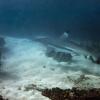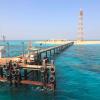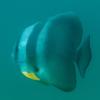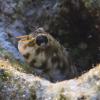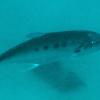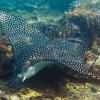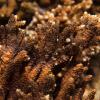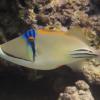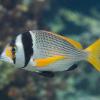Blacktip Reef Shark spotted in Kuwait waters
127 fish species seen near Qaru Island
By Dareen Almojil and Nancy Papathanasopoulou
First published in the Arab Times July 6, 2011
Wrapping up its work inAugust 2011 and sponsored by TOTAL Foundation and TOTAL Kuwait, the Kuwait Turtle Conservation Project (KTCP) wason islands Qaru and Umm Al-Maradim for three full years, mon-itoring sea turtle populations alongwith their nesting and hatchinghabitats in Kuwait. Both islandssport vibrant coral reef areas andQaru especially boasts at least 127species of fish, as well as crustaceans, molluscs and even some passing birds such as kestrels, cormorants, hoopoes, herons, terns and waders.
Big fish such as Queenfish (Scomberoides commersonianus) and Yellowtail Barracuda (Sphyraena flavicauda) as well as the impressive Teira Batfish (Platax teira) and multitudes of jacks, angelfish, parrotfish, gobies, blennies, snappers, rabbitfish, sweetlips, rubberlips, surgeonfish, trunkfish and butterflyfish form lively crowds in and around the corals of the island. Big predators such as sharks had nonetheless never been observed here for the longest of times. This reality changed during the KTCP mission of June 2011.
As researchers snorkeled close to the pier of the island, and for the first time ever, not only in Qaru but also in Kuwait, they spotted and photographed a Blacktip Reef Shark (Carcharinus melanopterus) underwater. It measured around 1.5 meters, was initially briefly seen on the 18th of June in 1.5m of water depth vanishing in deeper waters almost as fast as it had appeared, then seen feeding for several minutes and photographed on the 19th of June. It was seen again on the 21st, feeding on Sind Halfbeak Needlefish (Hyporhamphus sindensis).
Common along Oman’s coastline, especially in shallow inshore waters of coral reef areas and with a small home range area, which it inhabits for several years, the graceful Blacktip Reef Shark is very shy and avoids divers. Its distinctive traits are the prominent black tips to the fins and the creamy gray gradient around its first dorsal fin. Its maximum recorded length was 2 meters. A light lateral streak along its sides is another characteristic trait of this majestic fish. As it likes to feed on reef fishes and cephalopods, it is estimated that it may have been attracted by the large numbers of cuttlefish and needlefish in the Qaru island area.
Along the Arabian/Persian Gulf C. melanopterus has only been encountered close to the shores of Khor Fakkan and Abu Dhabi waters. Information on the species regional distribution, demography, status and ecology remains with little information if not null.
In Kuwait there is not a single conservational study aiming at the protection of sharks. A possible reason for this lack of information is their low economical value to the country. Ironically, studies have shown that the abundance of top predators has a direct effect on the abundance of other economically important fish, including groupers and emperors. Understanding and conserving these vital members of the ecosystem is of crucial need when seeking to ensure sustainability of local, economically important fish stocks.
In general, knowledge of elasmobranchs’ spatial distribution in the Arabian Gulf is limited to records from the 1940s and 1980s. Reports indicated uncertain information due to identification difficulties among species of the Carcharhinidae family. The most recent contribution to the ist of regional Shark species diversity was produced in 2010 by Moore et al. showing no records of C. melanopterus.
This June 2011 encounter in Qaru is of great value not only because it confirms the presence of C. melanopterus in Kuwait, but also because it reflects possible signs of improvement in the health of the local coral reef ecosystem. Since sharks are top predators, they detect weak individuals or species and prey on them. They therefore ensure a healthy, strong gene pool in the fish population as well as stronger, more resistant species over time. This process is vital to ensure healthy control on biodiversity, high standard ecosystem health and life sustainability.
Sharks are close to being lost to our seas. The shark fin trade especially has inflicted a tremendous decline to certain populations, yet their conservation is crucial, not only because they have inhabited the earth 250 million years before dinosaurs and the direct dependency of healthy fishstocks on them but also because they are the oldest animals known to have antibodies and are believed to be the hope for the production of a new generation of medicine in the future that might provide solution for inhibiting the growth of tumor cells.
Their ecological and economical importance is still such that we yet need to discover and understand.
Unfortunately, Shark encounters have been extremely rare in Kuwait since the 1980s, mostly due to overfishing and habitat destruction. In the past, Kuwaiti people relied on their sea as their main source of food, employment and income. Back then, understanding and care were given in order to ensure not only sustainability of the fishermen’s income but also the future of their children’s resources.
Today, however, with the introduction of the oil industry as the country’s main source of income, the importance of sustainably managing marine resources is not a priority anymore. The current attitude is "fish it all before someone else does", when it should probably be "conserve sustainably and diversify Kuwait’s economy,thus securing future generation food supply independently of the potentialcourse of petrol".
Dareen Almojil is with the Kuwait Environmental Research and Awareness Center (KERA) while Nancy Papathanasopoulou heads the Kuwait Turtle Conservation Project.


